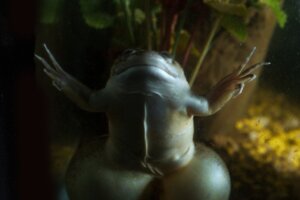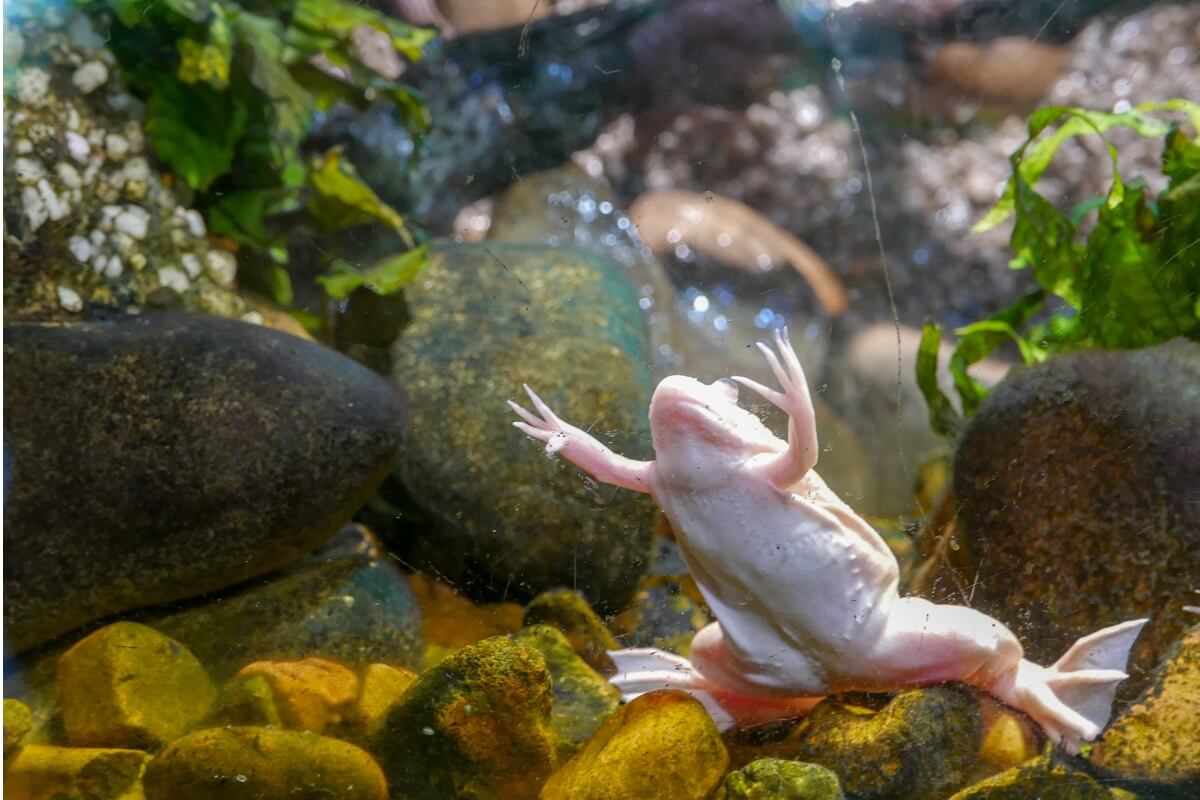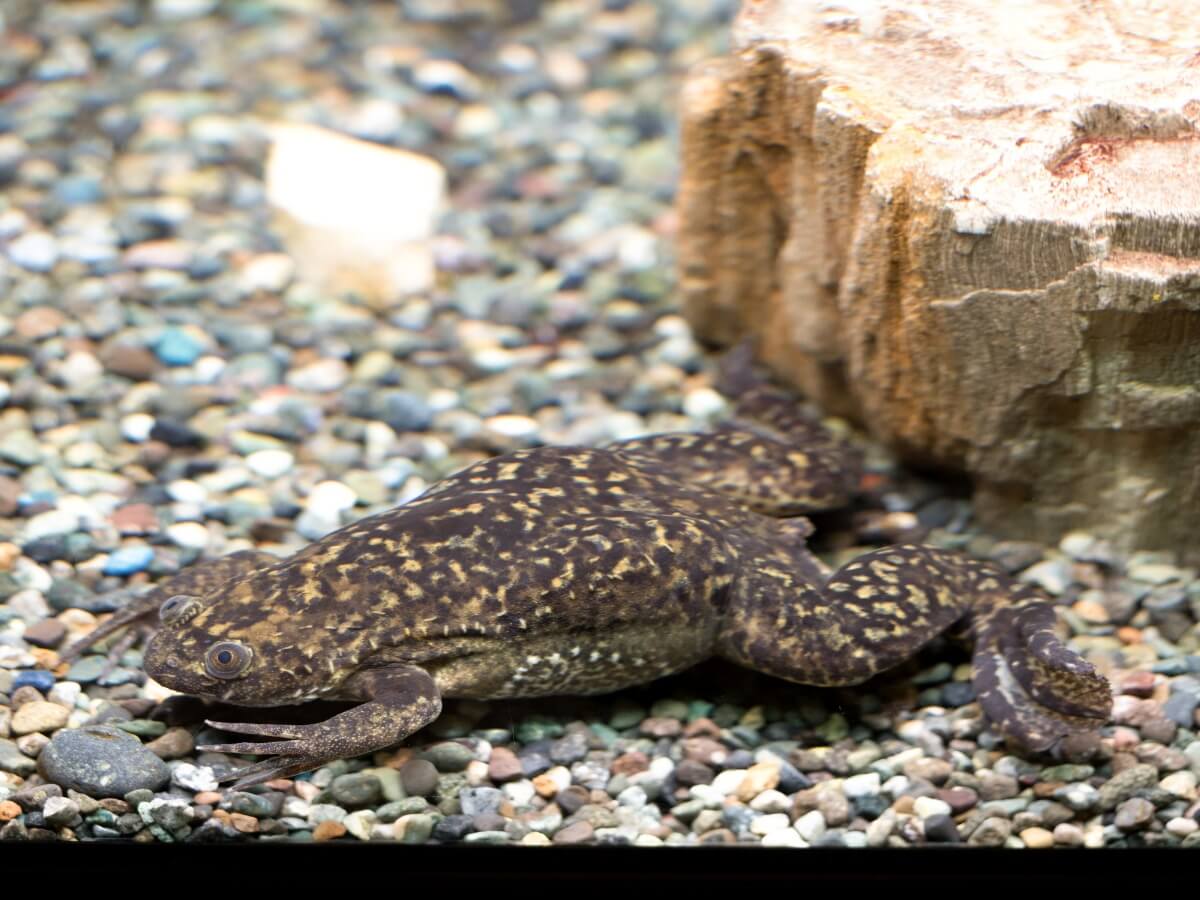African Clawed Frog: Habitat and Characteristics

The African clawed frog (Xenopus laevis) belongs to the group of anurans of the family Pipidae, whose representatives are all known as clawed frogs and are distributed throughout South America and sub-Saharan Africa. However, the species has also been introduced in California, Chile, England, and Spain.
In some of these countries, it’s considered an invasive species and a pest that can affect the local fauna. Interestingly, this frog can also be kept as a pet if its specific needs are met (and if it’s legal in your country). Below you’ll find the most relevant information about this amphibian.
African clawed frog habitat
As its name suggests, the African clawed frog is most prevalent in the southeastern part of the continent of Africa. This animal prefers to live in warm, stagnant grassland ponds that lack overhead vegetation, but that are covered with green algae. It’s also commonly seen in arid or semi-arid regions with have streams.
This species is able to tolerate different variations in the pH of the water, but the presence of metal ions is toxic to it. Temperatures in its natural habitat usually range between 15 and 26 degrees Celsius (59 to 79 F). It’s a completely aquatic animal, as it only leaves the water when it’s forced to migrate to another lake habitat with the aforementioned conditions.
This is one of the few frog species that never leaves the water.

Physical characteristics
One of the most important physical curiosities of this amphibian is that it doesn’t have a visible tongue nor ears. Its body is flattened and its head is triangular in shape (and smaller than the rest of the body shape). In addition, it has two small eyes located on the top of its head and no eyelids.
Its forelimbs are small and aren’t webbed, although they do have elongated toes that are essential for feeding. Its hind legs are large, webbed and have three inner toes on each foot, from which their claws or nails protrude. The frog’s skin is smooth and slippery, with olive-grey or brown and grey spots on the dorsal area.
The lower part of the frog’s body is white with a yellowish tinge. In addition, along its back it has a lateral line of a sensory nature. It has a clear sexual dimorphism: males are smaller than females, as they measure between 5 and 6 centimeters long (around 2 inches) and weigh around 60 grams (2 oz)
The males of the African clawed frog don’t have a vocal sac, a feature that most male amphibians do have. Females, on the other hand, are much larger, weighing in at almost 200 grams (8 oz), and are 10 to 12 centimeters long (4 – 5 inches) with cloacal extensions at the end of the abdomen.
African clawed frog behavior
This amphibian is quite inactive and can live 15 years in the wild and up to 20 years in captivity. Its efforts to survive the dry season become evident when the ponds it inhabits dry out, as it’s forced to burrow into the mud to bury itself in a humid area and not die from dehydration.
In general, this amphibian can remain up to a year without doing any activity other than moving ponds. However, when the rains come to its habitat, it puts its excellent swimming skills to use. In contrast to other frogs, this species can’t jump easily, but it is able to crawl.
The African clawed frog has well-developed lungs that it breathes with. Because it spends so much time underwater, it could be assumed that its gas exchange is mostly cutaneous, but, in fact, it uses this type of respiration to a lesser extent.
To breathe, the African clawed frog gasps at the surface of the water.
African clawed frog: diet
The African clawed frog feeds on live, dead, or dying arthropods and also on carrion or organic waste. It’s characterized by a large appetite, so it generally attacks any insect or small vertebrate that crosses its path. Thanks to its sense of smell, sensitive fingers, and a system of lateral lines, it can easily locate its food.
In captivity, this amphibian feeds on small fish, insects, worms and live or dried brine shrimp.
These lateral lines detect vibrations in the water and are analogous to a system found in most fish. The frog also relies on a hyobranchial pump to suck food into its mouth. The nails on its hind legs help it tear its food into smaller pieces and the front toes are useful for pushing prey.
In contrast, tadpoles usually feed on the organic matter present on the water beds. Their diet changes as they undergo metamorphosis, although they don’t leave the water at any time during the process.
Reproduction of the African clawed frog
The African clawed frog usually reaches sexual maturity at 10 to 12 months of age. Mating can occur at any time of the year, although it’s most common during the spring and can take place up to four times a year. During the night, males croak to attract females.
Although the male lacks a vocal sac, he quickly contracts his intrinsic laryngeal muscles to produce a mating call with long and short trills. When the female hears the sound, she performs an acceptance call similar to the sound of a thump or makes a rejection call with a slow ticking tone.
Reproduction of this species is among the rarest in the world, as a female rarely responds to a male’s call. Likewise, their mating embrace or amplexus is pelvic, while that of most frogs is axillary.
The African clawed frog releases hundreds of sticky eggs during mating, which lasts 3 to 4 hours. These eggs usually adhere to plants or any surface until the tadpoles emerge after 7 weeks. These metamorphose after a variable time into small frogs that absorb their tails to maintain their nutritional needs for 4 to 5 days.
Conservation status
According to the International Union for Conservation of Nature (IUCN), the conservation status of the African clawed frog is “Least Concern (LC)”. It’s also considered an invasive species in many countries, as it was used in embryonic segmentation research around the world (especially in human pregnancy tests) and some specimens ended up escaping.
Interestingly, the species Xenopus laevis was the first vertebrate to be cloned in a laboratory. Unfortunately, in the 1940s, this amphibian was released in several countries due to bad practices, causing the displacement of native species. For this reason, in countries such as Spain, its introduction, traffic or trade is prohibited.

As you can see, the African clawed frog is a unique animal, but it threatens the survival of other animal species if it’s introduced into foreign ecosystems. This is why you should inform the environmental authorities of your country if you want to keep it as a pet or if you find a specimen released in the wild.
The African clawed frog (Xenopus laevis) belongs to the group of anurans of the family Pipidae, whose representatives are all known as clawed frogs and are distributed throughout South America and sub-Saharan Africa. However, the species has also been introduced in California, Chile, England, and Spain.
In some of these countries, it’s considered an invasive species and a pest that can affect the local fauna. Interestingly, this frog can also be kept as a pet if its specific needs are met (and if it’s legal in your country). Below you’ll find the most relevant information about this amphibian.
African clawed frog habitat
As its name suggests, the African clawed frog is most prevalent in the southeastern part of the continent of Africa. This animal prefers to live in warm, stagnant grassland ponds that lack overhead vegetation, but that are covered with green algae. It’s also commonly seen in arid or semi-arid regions with have streams.
This species is able to tolerate different variations in the pH of the water, but the presence of metal ions is toxic to it. Temperatures in its natural habitat usually range between 15 and 26 degrees Celsius (59 to 79 F). It’s a completely aquatic animal, as it only leaves the water when it’s forced to migrate to another lake habitat with the aforementioned conditions.
This is one of the few frog species that never leaves the water.

Physical characteristics
One of the most important physical curiosities of this amphibian is that it doesn’t have a visible tongue nor ears. Its body is flattened and its head is triangular in shape (and smaller than the rest of the body shape). In addition, it has two small eyes located on the top of its head and no eyelids.
Its forelimbs are small and aren’t webbed, although they do have elongated toes that are essential for feeding. Its hind legs are large, webbed and have three inner toes on each foot, from which their claws or nails protrude. The frog’s skin is smooth and slippery, with olive-grey or brown and grey spots on the dorsal area.
The lower part of the frog’s body is white with a yellowish tinge. In addition, along its back it has a lateral line of a sensory nature. It has a clear sexual dimorphism: males are smaller than females, as they measure between 5 and 6 centimeters long (around 2 inches) and weigh around 60 grams (2 oz)
The males of the African clawed frog don’t have a vocal sac, a feature that most male amphibians do have. Females, on the other hand, are much larger, weighing in at almost 200 grams (8 oz), and are 10 to 12 centimeters long (4 – 5 inches) with cloacal extensions at the end of the abdomen.
African clawed frog behavior
This amphibian is quite inactive and can live 15 years in the wild and up to 20 years in captivity. Its efforts to survive the dry season become evident when the ponds it inhabits dry out, as it’s forced to burrow into the mud to bury itself in a humid area and not die from dehydration.
In general, this amphibian can remain up to a year without doing any activity other than moving ponds. However, when the rains come to its habitat, it puts its excellent swimming skills to use. In contrast to other frogs, this species can’t jump easily, but it is able to crawl.
The African clawed frog has well-developed lungs that it breathes with. Because it spends so much time underwater, it could be assumed that its gas exchange is mostly cutaneous, but, in fact, it uses this type of respiration to a lesser extent.
To breathe, the African clawed frog gasps at the surface of the water.
African clawed frog: diet
The African clawed frog feeds on live, dead, or dying arthropods and also on carrion or organic waste. It’s characterized by a large appetite, so it generally attacks any insect or small vertebrate that crosses its path. Thanks to its sense of smell, sensitive fingers, and a system of lateral lines, it can easily locate its food.
In captivity, this amphibian feeds on small fish, insects, worms and live or dried brine shrimp.
These lateral lines detect vibrations in the water and are analogous to a system found in most fish. The frog also relies on a hyobranchial pump to suck food into its mouth. The nails on its hind legs help it tear its food into smaller pieces and the front toes are useful for pushing prey.
In contrast, tadpoles usually feed on the organic matter present on the water beds. Their diet changes as they undergo metamorphosis, although they don’t leave the water at any time during the process.
Reproduction of the African clawed frog
The African clawed frog usually reaches sexual maturity at 10 to 12 months of age. Mating can occur at any time of the year, although it’s most common during the spring and can take place up to four times a year. During the night, males croak to attract females.
Although the male lacks a vocal sac, he quickly contracts his intrinsic laryngeal muscles to produce a mating call with long and short trills. When the female hears the sound, she performs an acceptance call similar to the sound of a thump or makes a rejection call with a slow ticking tone.
Reproduction of this species is among the rarest in the world, as a female rarely responds to a male’s call. Likewise, their mating embrace or amplexus is pelvic, while that of most frogs is axillary.
The African clawed frog releases hundreds of sticky eggs during mating, which lasts 3 to 4 hours. These eggs usually adhere to plants or any surface until the tadpoles emerge after 7 weeks. These metamorphose after a variable time into small frogs that absorb their tails to maintain their nutritional needs for 4 to 5 days.
Conservation status
According to the International Union for Conservation of Nature (IUCN), the conservation status of the African clawed frog is “Least Concern (LC)”. It’s also considered an invasive species in many countries, as it was used in embryonic segmentation research around the world (especially in human pregnancy tests) and some specimens ended up escaping.
Interestingly, the species Xenopus laevis was the first vertebrate to be cloned in a laboratory. Unfortunately, in the 1940s, this amphibian was released in several countries due to bad practices, causing the displacement of native species. For this reason, in countries such as Spain, its introduction, traffic or trade is prohibited.

As you can see, the African clawed frog is a unique animal, but it threatens the survival of other animal species if it’s introduced into foreign ecosystems. This is why you should inform the environmental authorities of your country if you want to keep it as a pet or if you find a specimen released in the wild.
All cited sources were thoroughly reviewed by our team to ensure their quality, reliability, currency, and validity. The bibliography of this article was considered reliable and of academic or scientific accuracy.
- Garvey, N. 2000. “Xenopus laevis” (On-line), Animal Diversity Web. Recogido el 3 de octubre de 2021 de: https://animaldiversity.org/accounts/Xenopus_laevis/
- IUCN SSC Amphibian Specialist Group. 2020. Xenopus laevis. The IUCN Red List of Threatened Species 2020: e.T110466172A3066881. Recogido el 5 de octubre de 2021 de: https://www.iucnredlist.org/species/110466172/3066881
- Anfibios del Ecuador. Version 2021.0. Museo de Zoología, Pontificia Universidad Católica del Ecuador. Amplexus. Recogido el 6 de octubre de 2021 de: https://bioweb.bio/faunaweb/amphibiaweb/Glosario/Definicion/127
This text is provided for informational purposes only and does not replace consultation with a professional. If in doubt, consult your specialist.








